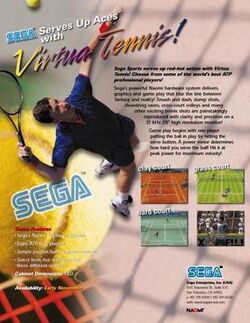Virtua Tennis
Topic: Software
 From HandWiki - Reading time: 3 min
From HandWiki - Reading time: 3 min
| Virtua Tennis | |
|---|---|
 Arcade flyer | |
| Developer(s) | Sega AM-3 |
| Publisher(s) | Sega |
| Composer(s) | Chiho Kobayashi |
| Series | Virtua Tennis |
| Platform(s) | Arcade, Dreamcast, Microsoft Windows, Game Boy Advance, N-Gage |
| Release | Arcade 1999 Dreamcast 2000 Microsoft Windows 2002 Game Boy Advance NA 2002 EU 2003 N-Gage 2003 |
| Genre(s) | Sports game |
| Mode(s) | Single player, multiplayer |
| Cabinet | Upright |
| Arcade system | Sega NAOMI |
| Display | Raster, medium resolution |
Virtua Tennis (Power Smash in Japan) is a 1999 tennis arcade game created by Sega-AM3. The player competes through tennis tournaments in an arcade mode. For the home console market the game was expanded with the introduction of the campaign mode. It was later ported to Dreamcast in 2000, and for Microsoft Windows in 2002. A Game Boy Advance version was also released in 2002.
A sequel, Virtua Tennis 2, was released in 2002 and was later updated and ported for the PlayStation Portable, under the name Virtua Tennis. 2006 saw the release of Virtua Tennis 3 in the arcades (using the Sega Lindbergh hardware). Xbox 360, PlayStation 3, PlayStation Portable and PC versions were released in 2007. Virtua Tennis 2009, was released on June 9, 2009 on PC, PS3, Xbox 360 and Wii platforms.[1][2] The latest addition to the franchise, Virtua Tennis 4, was released on May 10, 2011.
Game Modes
Arcade
The player must win 5 matches played on different surfaces and venues to win a tournament. If the player performs well enough, he is challenged by Master, one of the game's bosses.
Exhibition
This is a single match in which the options are customizable.
The match can be played as singles or doubles with up to 4 human players (2 for singles). The duration can be varied between one game and one set. Other options include the court that the match is played on and the skill of the opponent(s).
World Circuit
Users have to win matches and complete training exercises in order to progress and unlock new ones. The user enters with a rank of 300th, which improves as matches are won. These matches are unlocked by completing easier matches or training exercises. The focus of the training exercises are to be fun, rather than realistic. Each exercise has three levels, with the difficulty increasing progressively. By completing the hardest difficulty with a certain amount of time left or points scored, an outfit is unlocked, which players can wear in all modes.
Reception
| Reception | ||||||||||||||
|---|---|---|---|---|---|---|---|---|---|---|---|---|---|---|
| ||||||||||||||
Virtua Tennis received very positive reviews with the UK version of the Official Dreamcast Magazine rating it at 9/10, as well as overwhelmingly positive reviews from users.[6] Players were pleased with the quick learning curve and the wide variety of training exercises available.[citation needed] The game became one of the few Sega All Stars.[citation needed]
It has been ranked in the top 100 games of all time by IGN both in 2005 (#91)[7] and 2003 (#89).[8]
In Japan, Famitsu magazine scored the Dreamcast version of the game a 33 out of 40.[9]
It was also featured in Guinness World Records 2017: Gamer's Edition where it says that the game got GameRankings score of 91.37% based on 33 reviews.[10]
Virtua Tennis was nominated for PC Gamer US's "2002 Best Sports Game" award, which ultimately went to Tiger Woods PGA Tour 2003.[11]
References
- ↑ Ellie Gibson (2009-02-05). "SEGA announces Virtua Tennis 2009". http://www.eurogamer.net/articles/sega-announces-virtua-tennis-2009. Retrieved 2018-01-14.
- ↑ "Amazon.com: Virtua Tennis 2009: Video Games". https://www.amazon.com/s/ref=nb_ss_vg?url=search-alias%3Dvideogames&field-keywords=Virtua+Tennis+2009&x=0&y=0. Retrieved 2018-01-14.
- ↑ "Virtua Tennis". CBS Interactive. http://www.gamerankings.com/dreamcast/199207-virtua-tennis/index.html. Retrieved 2018-01-14.
- ↑ "Virtua Tennis". CBS Interactive. http://www.metacritic.com/game/dreamcast/virtua-tennis. Retrieved 2018-01-14.
- ↑ "Virtua Tennis: Sega Professional Tennis". News Corporation. 2000-07-08. http://www.ign.com/articles/2000/07/08/virtua-tennis-sega-professional-tennis. Retrieved 2018-01-14.
- ↑ "Virtua Tennis for Dreamcast". http://www99.epinions.com/game-Software-All-Dreamcast-Virtua_Tennis/display_~reviews/sec_~opinion_list/pp_~6. Retrieved 2018-01-14.
- ↑ "IGN's Top 100 Games". News Corporation. http://top100.ign.com/2005/091-100.html. Retrieved 2018-01-14.
- ↑ "IGN's Top 100 Games of All Time". News Corporation. http://top100.ign.com/2003/81-90.html. Retrieved 2018-01-14.
- ↑ ドリームキャスト - Power Smash (パワースマッシュ). Weekly Famitsu. No.915 Pt.2. Pg.44. 2006-06-30.
- ↑ Guinness World Records 2017 Gamer’s Edition. Guinness World Records. p. 61. https://books.google.com/books?id=SSJoDQAAQBAJ&pg=PA61.
- ↑ Staff (March 2003). "The Ninth Annual PC Gamer Awards". PC Gamer US 10 (3): 48-50, 54, 58, 60, 66, 68, 70.
External links
 KSF
KSF